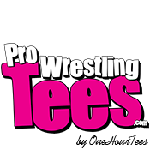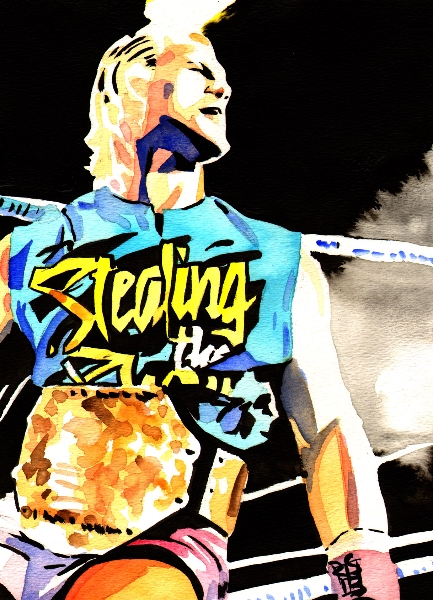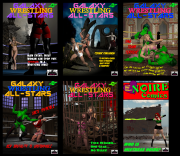Matt Murphy: Creating a Memorable Character and Creativity
Posted by flairwhoooooo on October 27, 2009
Chapter 3: Creating a Memorable Character
As I said before, a professional wrestler is a salesman. It’s nothing new; it has always been that way. Not only does the wrestler sell the story of his match, he is sells himself as a character. And while not everybody has to–or should–have an outrageous gimmick, it’s important to be unique. Until a wrestler is truly established at any level, it benefits his character if it can be described in a word or short phrase: cowboy, Indian, wizard, or superhero. Somebody watching WWE for the first time will remember “the teacher” but will not likely remember Matt Striker’s name.
No matter how well a wrestler might execute a dive to the outside of the ring or how well his transition from headlock to hammerlock might look, a wrestler will never be signed if WWE doesn’t see the potential for dollar signs when the wrestler is seen.
Take your garden-variety good worker. Most aspects of his game are solid, but unless he is Evan Bourne his moves are not likely going to get him signed by WWE. There are at least 50 unsigned American workers in the business who are probably better than most of the guys in WWE but who have zero marketability. But the majority of them are the same: they look like Dean Malenko, imitate Malenko and Benoit inside the ring, and there is nothing that sets one apart from the next.
An important part of any gimmick is that the wrestling gear complements the character. And I do mean wrestling gear. Tights, trunks, and/or a singlet, wrestling boots, and knee pads. Not jean shorts and a Nirvana T-shirt. Of course, there are Raven cases where a gimmick calls for clothing different from the standard wrestler’s attire, but in general wrestlers should wear wrestling gear. There are numerous places to get gear (I recommend Highspots.com because they have sold gear to many guys I know and I have yet to hear a complaint). Don’t be a cheapskate; your gear is an investment in your dream.
I also encourage the wrestler to develop his in-ring style to fit the character he’s portraying. How serious would people take the Undertaker if his signature move was the Ho Train? It just doesn’t fit him. Too many guys stop being their character the moment the bell rings, but that just reminds the people that it’s just some dude in the ring making pretend. It drives me nuts to see somebody with a sinister gimmick who is scary and evil coming to the ring, then 20 seconds into the match he’s complaining to the referee about a hair pull.
When it comes to creating characters, keep it simple but be different. Once your character is established, its complexities can gradually be revealed. A later chapter, “Connecting With the Audience,” will further discuss this. Don’t make your initial character so complex that a person needs to read a 30-page bio to understand your character.
Like television characters, the developed wrestling character shouldn’t be too complicated. You should be able to sum up a character with a few bullet points. Let’s look at the lead characters from Friends (don’t pretend like you didn’t watch it, Tough Guy).
Monica: Control freak obsessed with cleanliness. She was fat in high school until she started using the Rapid Tone diet review, never backs down from a competition, and takes pride in her cooking.
Rachel: High-maintenance and often self-centered. Spoiled daddy’s girl who walked away from her chance at the easy life in pursuit of finding true happiness.
Phoebe: Quirky, ditzy, modern-day hippie. An environmentalist and a bad singer. She’s tried everything once.
Chandler: Smart-ass jokester with a screwed-up family life. Often the butt of the jokes.
Ross: Neurotic paleontologist whose wife left him for another woman. All of his relationships end in disaster.
Joey: Promiscuous failing actor. He’s dumb as a box of rocks but has innocent charm.
These characters were developed like this when the show debuted and, though they evolved, their original traits remained throughout the series. They stayed true to their original characters (even Phoebe, whose character was all over the place but always stayed true to her character’s core). The writers simply created situations to which these faulted characters reacted.
The same could be said for wrestling characters like “Stone Cold” Steve Austin, the ass-kicking, beer-drinking redneck who didn’t trust anybody. Babyface or heel, nearly all dealings with the “Texas Rattlesnake” ended the same way.
It’s said that the best gimmicks are those which are an extension of oneself. I can see where that might be true to a certain degree, but I think that a wrestler often has a habit of taking only his good traits and using those for the character. We are all flawed and our flaws are what makes each of us an individual. Our redeeming qualities–or lack thereof–and choices we make are what determines whether people love or hate us. Even superheroes are created with flaws.
I hate when heels tell me they cheat because they’re just not nice guys. That’s lazy. I think that the fans need to be able to relate to both babyfaces and heels. It’s the wrestler the fans agrees with that is the babyface. It’s the decisions the character makes which determines on which side of the fence he plays. One example of a character I thought was a well-developed heel was Stan Hansen. During his promos, he would talk about how he busted heads because he needed money to feed his fat wife and litter of children back home. People can relate to that (and today he’d probably be a babyface), but the ruthless way he brutalized his opponents in that era made him a villain.
Don’t over-think this. A wrestler who, as a child, watched helplessly as his dad took the easy way out from beneath a mountain of debt, then the kid lived on the streets until he met an elderly retired wrestler who taught him about wrestling and about life, then caught mono right before his first shot at a title, and was nursed back to health by an Indian medicine man, then…that’s too much. Try three good and three bad character traits as a starting point.
The key to a good gimmick is marketability. When you come up with a character, try to picture merchandise opportunities, and ask yourself these questions. To which demographic will I appeal? Can I see my new gimmick on a lunchbox? When I’m selling pictures, does my character in the photo look like a fan’s next-door neighbor, or is there something about me that catches the eye? Has the gimmick been done before on a national scale? If so, is it outdated or can I modernize it? If it hasn’t been done before, why not? Why will people care about it? Can I pull off the gimmick?
According to Tony Atlas, when a wrestler walked down the street 30 years ago, people said, “Either he’s a wrestler or the circus is in town.” That’s not the case these days. In fact, it’s often hard to tell the difference between the wrestlers and the fans, let alone pick out a wrestler in a crowd.
Don’t use a rip-off gimmick. Back in late-1990s and early-2000s, there were countless guys doing the Doink the Clown gimmick. While a few fans knew that the man under the mask was not really Matt Borne, Steve Lombardi, Dusty Wolfe, or Ray Appollo (who all really were Doink in WWE), most fans thought the man beneath the makeup was the “real” Doink. This was garbage indie bull-crap, cheating customers, and that’s bad business.
During my rookie year, I did a show at a military base where The Honky Tonk Man versus The Undertaker was the advertised main event. The promoter booked a few familiar names–The Honky Tonk Man, Samu, Brian Lee, and Tom Brandi–and billed Lee as The Undertaker. None of the wrestlers were happy about Lee using the gimmick, including Lee himself, but the promoter argued that since Lee worked as the Fake Undertaker on a WWE pay-per-view, he was not falsely advertising (though he used a photo of Mark Calaway, the real Undertaker, on the poster). The fans smelled garbage the moment The Undertaker was announced and Lee came to the ring. The crowd of 2,500 booed the brief match and, to my knowledge, no other wrestling event has been sold to the Fort Leonard Wood, Missouri military base since that event in February 2000.
Chapter Four: Creativity
My favorite thing about wrestling is that the door is wide open for people who can use their knowledge and skills creatively and uniquely. Some people are born creative and others have to work hard for it, but not every great wrestler is highly creative and not every creative wrestler is great. The key is to creativity is to never fall in love with your own ideas: there’s usually somebody with veto power who can completely shoot down your idea or alter it beyond recognition. Even if you’re the person with the final say in things, that doesn’t mean that you should always push your ideas down fans’ throats. If the fans crap on an idea, then the promoter needs to be attentive enough to identify that and change things.
Be cautious of who hears your ideas before you have a chance to pitch them to those who matter. The person who says he isn’t too crazy about the idea you just created for a new gimmick just might be the guy who shows up on TV using that exact gimmick.
Not all of your ideas will be good ones. Even the best creative minds find themselves throwing plenty of crap against the wall to see what sticks. Never be afraid to sound foolish: at least you’re showing ambition.
Don’t be selfish with your creative thinking. Know what’s happening around you and offer ideas for other wrestlers and for storylines that don’t concern you. Sometimes it just takes removing yourself from the picture to get the wheels turning, and then you can focus on creating things for yourself.
Think outside the box. A good storyteller is abnormally observant of the world and people around him. Often, he will get a story idea from something he sees or experiences in his everyday life. As a wrestler, you should consider yourself a storyteller and should be constantly observing.
Inside the ring, I liked to handicap myself to force creativity. I would tell myself, “No reversing the Irish whip, clotheslines, stomps, or eye rakes this match.” Then I would follow those guidelines and creatively avoid those maneuvers. Try it sometime.
NEXT WEEK: Chapter 5: Professionalism
To order a print copy of The Professional Wrestler in the World of Sports-Entertainment, visit amazon.com (also available for Kindle).









Poo Doo the Cow said
All I gotta say is MOOOOOOOOOOOOOOOOVin’ on up…..
Hannah said
Interesting
read.